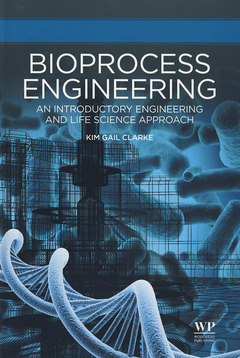Description
Bioprocess Engineering
An Introductory Engineering and Life Science Approach
Language: English
Subjects for Bioprocess Engineering:
Publication date: 10-2013
266 p. · 15.5x23.2 cm · Hardback
Out of Print
Publication date: 10-2013
266 p. · 15.5x23.2 cm · Hardback
Publication Abandoned
Description
/li>Contents
/li>Biography
/li>Comment
/li>
Dedication
List of figures
List of plates
Preface
About the author
Chapter 1: Historical development: from ethanol to biopharmeceuticals
Abstract:
Chapter 2: Microbiology
Abstract:
2.1 Microorganisms: the core of cellular bioprocesses
2.2 Cellular structure and sites of metabolic reactions
2.3 Classification according to carbon and energy requirements
2.4 Nutrient requirements
Chapter 3: Metabolic macromolecules
Abstract:
3.1 Carbohydrates
3.2 Lipids
3.3 Proteins
3.4 Nucleosides, nucleotides and nucleic acids
Chapter 4: Molecular biology
Abstract:
4.1 Replication, transcription and translation
4.2 Genetic regulation
4.3 Genetic modification
Chapter 5: Carbon metabolism
Abstract:
5.1 Energy generation, storage and transfer
5.2 Catabolic pathways: energy generation
5.3 Anabolic pathways: energy utilisation
Chapter 6: Enzymes as biocatalysts
Abstract:
6.1 Enzyme kinetics with no inhibition
6.2 Enzyme kinetics with inhibition
6.3 Enzyme reactors with soluble enzymes
6.4 Enzyme reactors with immobilised enzymes
Chapter 7: Microbial kinetics during batch, continuous and fed-batch processes
Abstract:
7.1 The nutrient medium
7.2 Batch process design equations
7.3 Continuous process design equations
7.4 Fed-batch bioprocess design equations
Chapter 8: The oxygen transfer rate and overall volumetric oxygen transfer coefficient
Abstract:
8.1 Oxygen transfer design equations
8.2 Measurement of the oxygen transfer rate
Chapter 9: Bioprocess scale up
Abstract:
9.1 Scale up with constant oxygen transfer rate
9.2 Scale up with constant mixing
9.3 Scale up with constant shear stress
9.4 Scale up with constant flow regime
Chapter 10: Bioprocess asepsis and sterility
Abstract:
10.1 Heat sterilisation of media and equipment
10.2 Filter sterilisation of air
Chapter 11: Downstream processing
Abstract:
11.1 Overview of potential recovery operations
11.2 Separation of cells and extracellular fluid
11.3 Cell rupture and separation of cell extract
11.4 Concentration and purification of soluble products
Index
- Details the application of chemical engineering principles for the development, design, operation and scale up of bioprocesses
- Details the knowledge in microbiology, biochemistry and molecular biology relevant to bioprocess design, operation and scale up
- Discusses the significance of these life sciences in defining optimum bioprocess performance
These books may interest you

Advances in Bioprocess Technology 147.88 €

Advances in Bioprocess Technology 179.34 €


